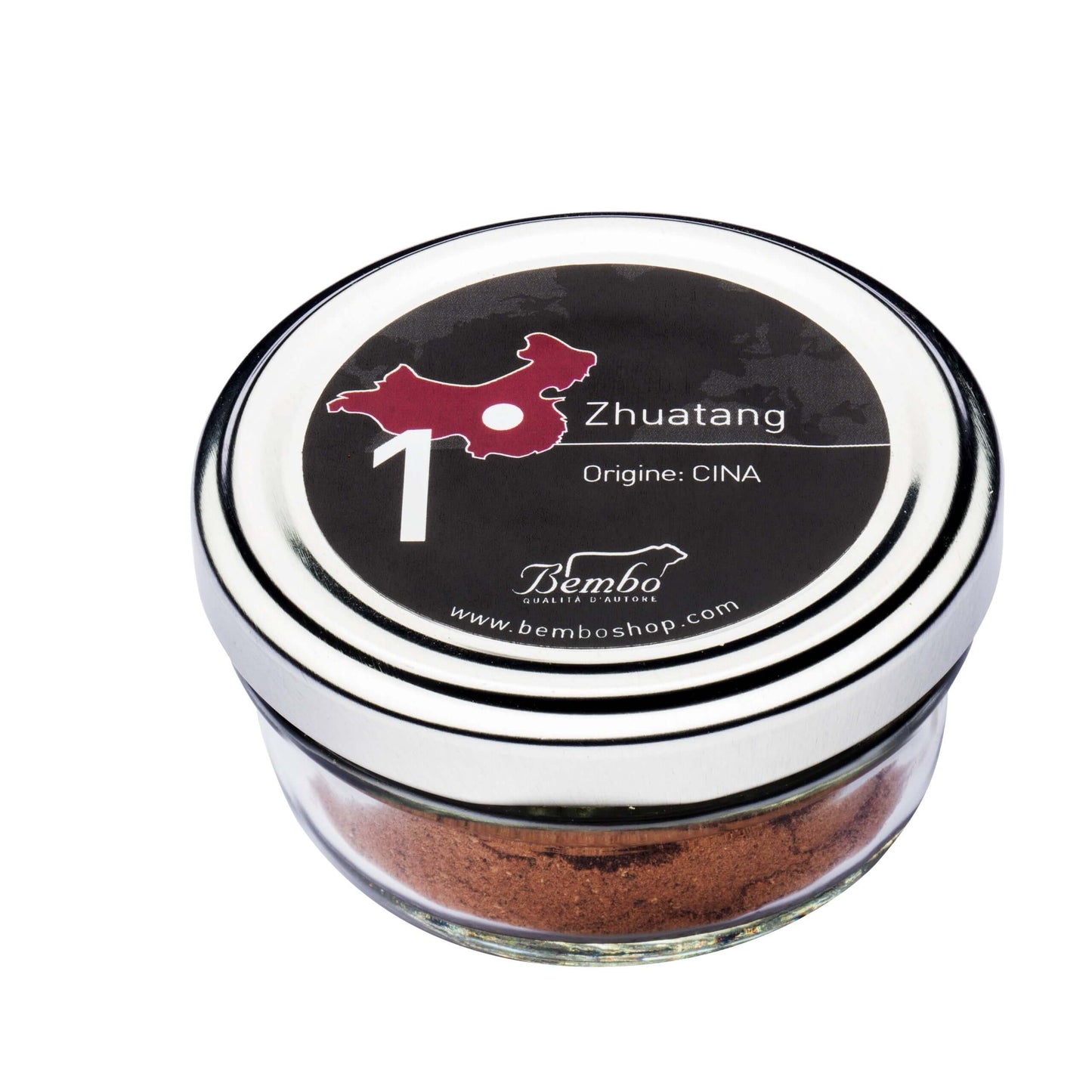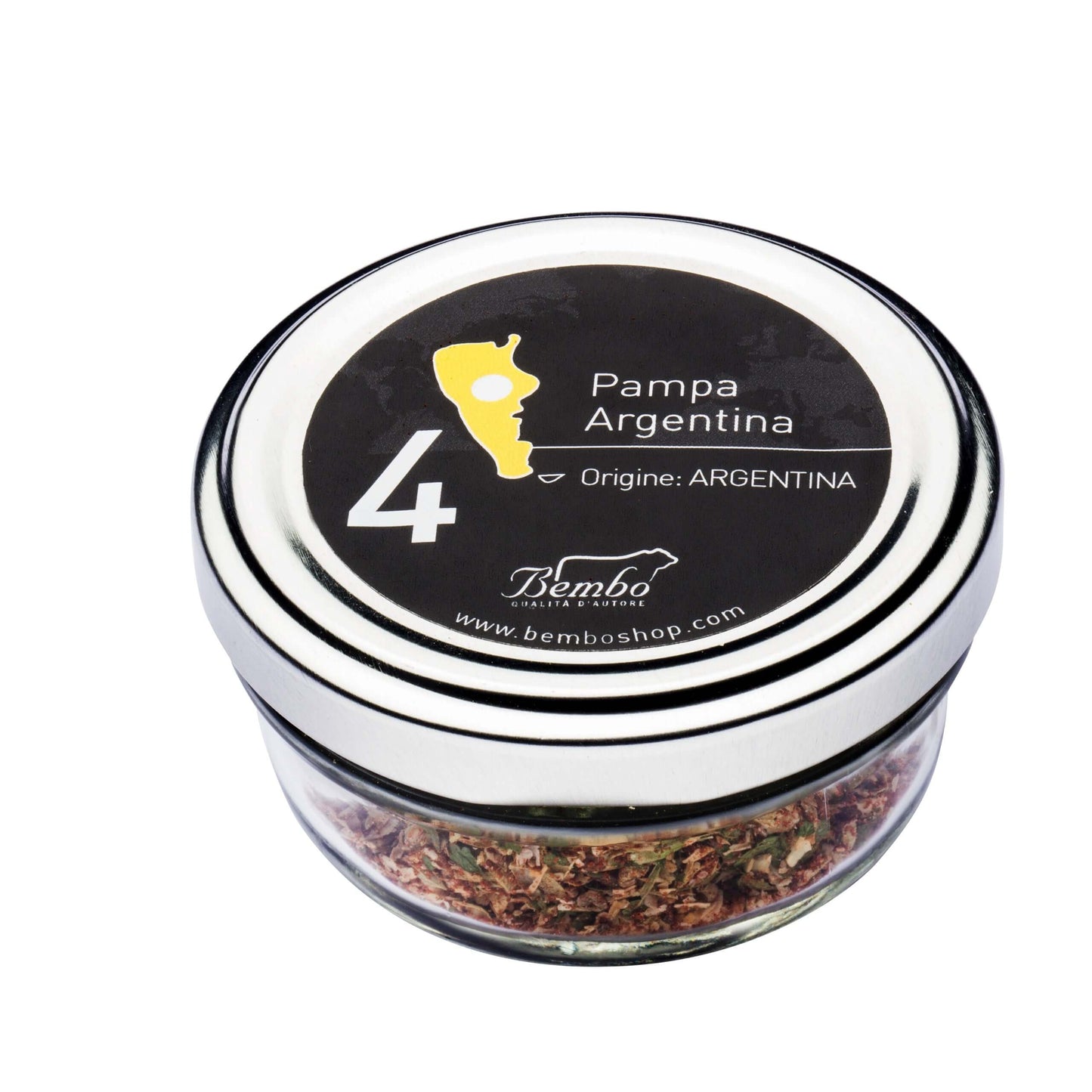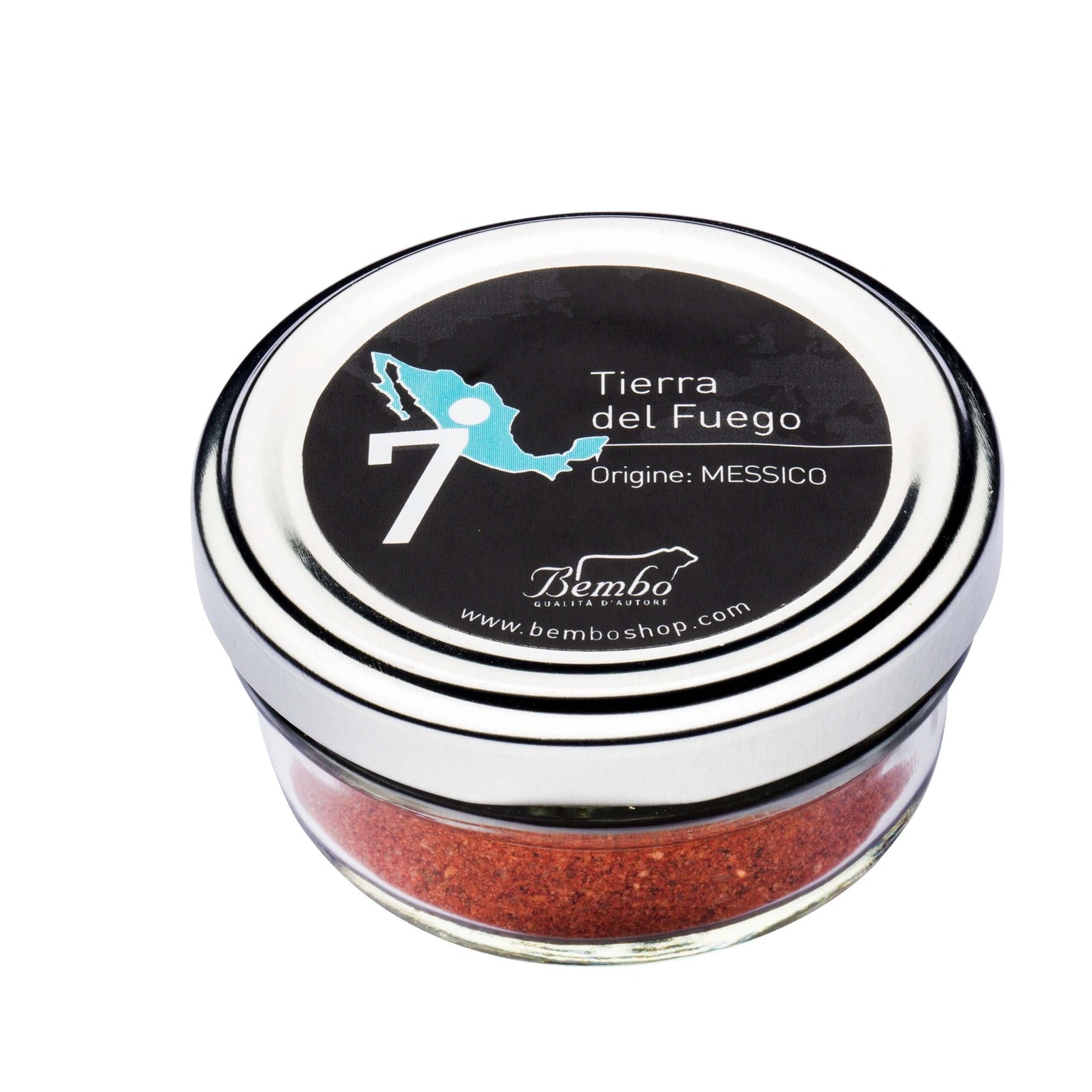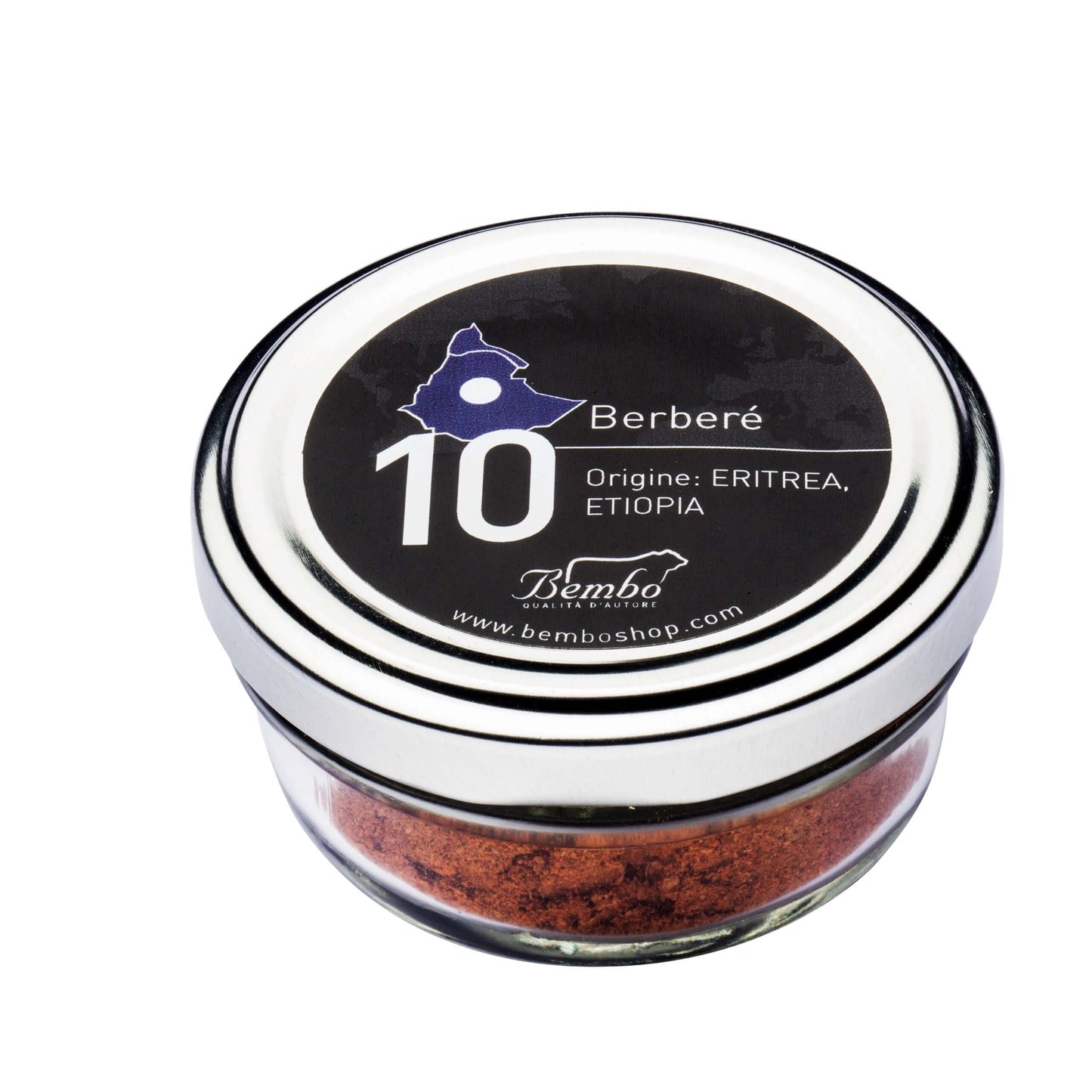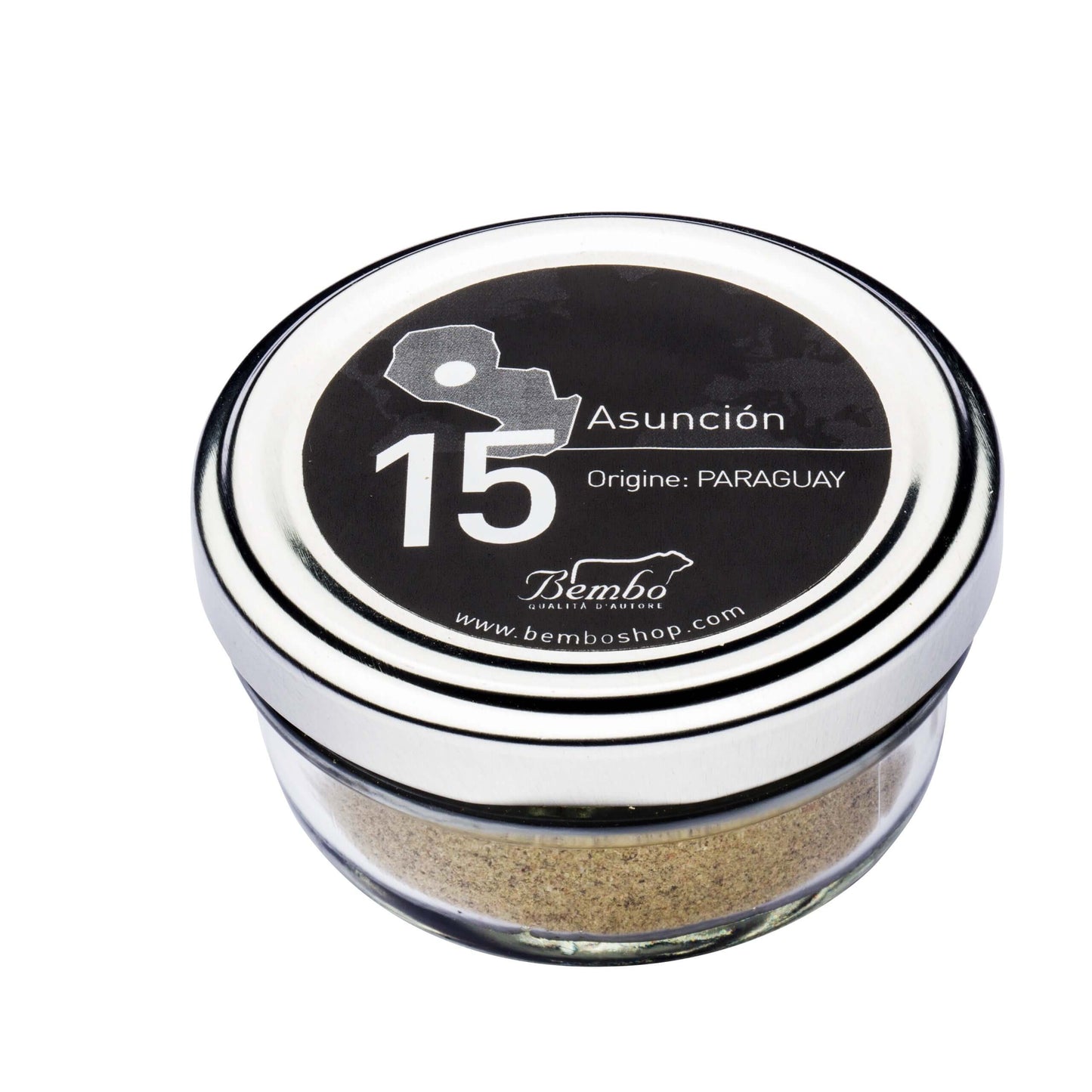1
/
of
17
Bembo
The World in 16 Spice Blends
The World in 16 Spice Blends
Regular price
€120,00 EUR
Regular price
Sale price
€120,00 EUR
Unit price
/
per
Tax included.
Shipping calculated at checkout.
Couldn't load pickup availability
Pairings
Pairings
Traveling the world to discover the 16 spice blends that have made history. Revisited by Bembo.
Average weight per jar : 20 g
#1 - ZHUATANG
Origin : China
Born around 1300, this blend is among the oldest in the world. Legend has it that it was created with the intention of bringing together all five flavors that form the basis of Chinese dietary theory: sweet (cinnamon), salty (cloves), bitter (anise), acid (fennel seeds) , spicy (pepper), and to balance Yin and Yang. In Chinese cuisine it is normally used to prepare the so-called "Lu" foods, a cooking method used to stew some dishes, generally fatty meats, such as pork and duck: thanks to the long cooking, the latter absorb all the aromas to the maximum. Also recommended with tofu, soups, sautéed vegetables and all the various noodle dishes.
Ingredients : Anise, Fennel, Cinnamon, Cloves, Black Pepper.
N°2 - MADRAS CURRY
Origin : India
This Curry is so famous that it has become synonymous with the word Curry in the world. Madras is the ancient name of the city of Chennai in southeastern India. It is a strong Curry which, depending on the amount of chilli pepper, can be more or less spicy. The prevailing flavor is that of turmeric: dry and enveloping. Then follow the spicy and particular notes of mustard and pepper, enhanced by the light smokiness of paprika. Cardamom, with its floral aroma, completes the blend.
Ingredients: Coriander, Turmeric, Fennel, Salt, Cumin, Garlic, Fenugreek, Laurel, Cloves, MUSTARD, Pepper, Smoked Paprika, Cardamom.
N°3 - PERDICIÓN
Origin : Polynesia
Even if there is no certain information, it seems that this simple aphrodisiac mixture was imported from French Polynesia in 1880 when King Pomare V agreed to cede the kingdom of Thaiti to France, obtaining its protection. On that occasion Pomare V, among other things, gave the French Prime Minister Jules Ferry the original recipe of this passionate mixture used by Polynesians in courtship rites. Brought home by Ferry, La Perdición was so successful that many French people forgot its origins, considering it a blend of French spices. This melange has a warm and intense aroma, mainly due to cinnamon and cloves and today, in French cuisine, it is used to flavor soups, meat sauces, sausages and pates and is also excellent combined with pork, poultry and mushrooms. Furthermore, it perfumes spicy sweet breads, puddings, dry biscuits or custard to be used in fruit tarts.
Ingredients : Black Pepper, White Pepper, Nutmeg, Cloves, Cinnamon, Ginger, Nigella.
N°4 - PAMPA ARGENTINA
Origin : Argentina
This blend of herbs and spices originated in Argentina and has spread throughout South America and Northern Europe. The flavor and aroma of onion and garlic stimulate the combination with grilled meat and fish. It lends itself to the composition of marinades with extra virgin olive oil, sprinkling the meat and letting it rest for at least an hour. The result will be amazing.
Ingredients : Garlic, Onion, Sweet Paprika, Oregano, Salt, Parsley, Pepper.
N°5 - PAIN D'ÉPICES
Origin : France
Pain d'Épices is a blend of spices created to flavor desserts, biscuits, bread, panna cotta, puddings and more. It comes from the small town of Colmar, the capital of Alsace, also known as the capital of the production of Alsatian wine. The origins of this sweet blend are lost in the mists of time. Greeks and Romans used to make sweet breads flavored with honey, but the most ancient ancestor of Pain d'Epices as we know it today can be found in a honey bread flavored with herbs and used as rations by the Chinese army around 1100 AD
Ingredients : Cinnamon, Anise, Cardamom, Coriander, Mace, Allspice, Ginger, Black Pepper, Cloves.
No. 6 - RAS EL HANOUT
Origin : Morocco
It is a blend of spices with warm and "sweet" and non-spicy scents, such as cinnamon, cloves, nutmeg. Since it can be considered a condiment, it is easy to use to marinate meat, perhaps mixed with fat, or transformed into a cream to spread not only on meat, fish or vegetables, but also on stews and tagines. To prepare a spread, add a teaspoon of Ras el Hanout to softened butter, sour cream or Greek yogurt; if, on the other hand, you want an emulsion to make your pinzimonio special, mix it with extra virgin olive oil.
Ingredients : Turmeric, Coriander, Allspice, Cinnamon, Chilli, Black Pepper, Cardamom, Ginger, Cumin, Fennel, Nutmeg, Star Anise, Orange Peel, Fenugreek, Bay Leaf.
N°7 - TIERRA DE FUEGO
Origin : Mexico
It is a blend with a spicy flavor thanks to its typical ingredients such as chilli pepper, onion, cumin and many others. Tierra del Fuego is perfect for barbecue cooking, but it can also be used for pan cooking. Also try it on grilled vegetables. Great for Churrasco. This blend of spices comes from the gaucha tradition of South America and must be rigorously used to support a decidedly hearty dish... based on different cuts of meat (beef, pork, sheep and chicken), perhaps skewered on a skewer and cooked on the embers.
Ingredients : Ancho Chilli, Mustard Seeds, Onion, Smoked Paprika, Black Pepper, Coriander, Garlic, Cumin, Sun-Dried Tomato, Oregano, Turmeric, Thyme, Marjoram, Nutmeg, Jamaican Pepper, Basil, Rosemary, Tarragon, Zeste Orange, Ginger, Smoked Salt, Raw Cane Sugar.
N°8 - COWBOYS
Origin : USA
An American BBQ classic. Natural coffee and cocoa are bitter, but they sweeten and harmonize perfectly with the other spices when they come into contact with heat. This blend, when used on red meats, transmits an energetic, unmistakable and exciting aroma, especially when the spicy notes of pepper and chili pepper meet those of coffee. Ideal for all beef, pork and lamb meats. An unmistakable and balanced flavor for a BBQ that will delight your guests.
Ingredients : Salt, Coffee, Black Pepper, Bitter Cocoa, Mustard, Chilli, Pimento, Laurel, Marjoram, Dill, Cloves.
N°9 - CAJUN
Origin : Louisiana
Cajun cuisine is a typical American cuisine born with French immigrants from Canadian Acadia and forcibly moved by the British to Acadiana, a colonial region of today's Louisiana and part of eastern Texas. Cajun foods are characterized by simple preparation and the use of rustic ingredients. This spicy spice blend is very popular in the USA and is suitable for all red meat and game dishes.
Ingredients : Thyme, Onion, Garlic, Sweet Paprika, Black Pepper, White Pepper, Salt, Chili Pepper, Oregano, Nutmeg, Cumin.
N°10 - BERBERÉ
Origin : Eritrea, Ethiopia
Berberé is the name of a mix of African spices, used in Eritrea and Ethiopia for the preparation of the famous national dish, the zighinì stew. The blend includes spices with innumerable properties: cardamom, chilli pepper, ginger, cloves, coriander, allspice, common rue, ajowan, sometimes even long pepper and fenugreek. There are essentially two types of Berberé: the one with fenugreek and the one with cardamom. Berberé can be used to spice up countless foods and dishes and to increase the use of spices in the kitchen, also helping to eliminate salt and fat.
Ingredients : Nutmeg, Coriander, Cardamom, Allspice, Black Pepper, Kummel, Cayenne Pepper, Ginger, Cloves, Salt, Fenugreek.
No. 11 - ZAHATAR
Origin : Lebanon
Zahatar is a very popular mix of spices in the area of the former Ottoman Empire (Lebanon, Egypt, Turkey, Syria, Israel and Jordan). In Israel it is very fashionable, as well as in Palestine where they consider it a typical ingredient of their cuisine. In Lebanon, children are raised on bread and zahatar as it is believed to strengthen the body and mind. Very versatile, Zahatar is used simply mixed with oil to dip bread, bagels, pitta or manakish, a kind of pizza common throughout the Middle East; in Palestine it is served with chickpeas and olives and is eaten, as well as as breakfast in the morning, also as a mid-morning snack, served with hummus; it is added to labne, yogurt that has the consistency of a cheese; it is also used to flavor meat and vegetables. You can use it to flavor an onion pizza or to flavor stewed potatoes; it is very pleasant to use it as a dry marinade for chicken or lamb and it is also tasty on tomatoes and mozzarella or on eggs.
Ingredients : Sesame, Sumac, Thyme, Marjoram, Coriander, Dill, Salt.
N°12 - MYKONOS
Origin : Greece
The Mykonos Herbal Blend was invented in the 1960s. It seems that one of the chefs on Aristotle Onassis' yacht, on the occasion of Jacqueline Kennedy's first visit, who would later become the Greek shipowner's wife, prepared this melange to dress a carrot, cucumber and tomato salad that Jacqueline was fond of. The guests were so enthusiastic that the recipe soon went around the world. This blend contains all the scents of the Mediterranean in an aromatic bouquet. It is a mixture particularly suitable for flavoring fish and white meats, eggs and sauces and dishes based on steamed vegetables and legumes. Also excellent for marinating meat to be cooked on the grill.
Ingredients : Thyme, Rosemary, Basil, Fennel, Sage, Marjoram, Mint, Oregano.
N°13 - SAN JOSé
Origin : Costa Rica
This blend, famous all over the world, has a strong personality characterized by a delicate balance between the different spices and, elegantly releasing sweet, spicy and salty notes, it creates an unusual and interesting flavour. In addition to the purely gustatory and olfactory aspects, a mahogany-colored bark on the meat is appreciable, guaranteeing a unique result in all its aspects. Particularly suitable for pork, San José lends itself to various uses with roasts and pork steaks, not to mention its effect on fries.
Ingredients : Salt, Cane Sugar, Chili Pepper, Garlic, Paprika, Celery, Cumin, Cayenne Pepper, Rosemary, White Pepper, Green Paprika.
N°14 - KASKA
Origin : Niger, Mali, Ghana
In some citations from the 13th century AD, a Syrian historian from Aleppo mentions Kaskà on four occasions, always pairing it with couscous. These ancient citations show that couscous, and therefore Kaskà, spread rapidly, but that in general they were common especially in the Islamic West up to Tripolitania, while further east, starting from Cyrenaica, the cuisine was above all Egyptian type for which couscous was only an occasional dish. One of the first references to Kaskà in northern Europe is in Brittany, in a letter dated January 12, 1699, but already much earlier it had made its appearance in Provence, where the traveler Jean Jacques Bouchard wrote that he ate it in Toulon in 1630. This mixture is not only essential for the preparation of couscous to which it is added during cooking, but it is a happy combination if combined with fish and lamb.
Ingredients : Coriander, Cumin, Paprika, Black Pepper, Chilli.
N°15 - ASUNCIÓN
Origin : Paraguay
This blend of spices, now well known throughout Europe, is said to have originated in the prairies of Estancia, in Paraguay. In that region, where meat is the food par excellence, what we know today as roast beef was born, a method of cooking meat on the grill until now erroneously attributed exclusively to England. The extensive livestock breeding practiced in Paraguay, the qualitative care of the production and the ability to cook the meat in the prairies during the pasture, confirm the influence this area has had on the history of this sirloin cut. In those green expanses, rich in pristine pastures, this blend of spices used by camperos to flavor grilled beef had its development.
Ingredients : Salt, Rosemary, Black Pepper, White Pepper, Garlic, Thyme, Marjoram, Oregano.
N°16 - KARIBES
Origin : Caribbean
It was the Caribbean Indians who invented this prodigious blend of spices which is now used all over the world as a basis for the preparation of barbecue or grilled meats. As early as the 15th century, these populations, nicknamed the "navigators of American prehistory", used spices to season meat and fish. Their cultural influence extended throughout Latin America, from Nicaragua to Brazil via the Amazon River and also in North America, forming the Carichana colony (Karb-Ana), Cariben. Even today, the success of this blend never ceases to amaze country cooking enthusiasts who use it with pork, beef and baked potatoes.
Ingredients : Salt, Pepper, Garlic, Paprika, Chilli, Mustard, Cayenne Pepper, Chives, Tarragon, Marjoram.
Average weight per jar : 20 g
#1 - ZHUATANG
Origin : China
Born around 1300, this blend is among the oldest in the world. Legend has it that it was created with the intention of bringing together all five flavors that form the basis of Chinese dietary theory: sweet (cinnamon), salty (cloves), bitter (anise), acid (fennel seeds) , spicy (pepper), and to balance Yin and Yang. In Chinese cuisine it is normally used to prepare the so-called "Lu" foods, a cooking method used to stew some dishes, generally fatty meats, such as pork and duck: thanks to the long cooking, the latter absorb all the aromas to the maximum. Also recommended with tofu, soups, sautéed vegetables and all the various noodle dishes.
Ingredients : Anise, Fennel, Cinnamon, Cloves, Black Pepper.
N°2 - MADRAS CURRY
Origin : India
This Curry is so famous that it has become synonymous with the word Curry in the world. Madras is the ancient name of the city of Chennai in southeastern India. It is a strong Curry which, depending on the amount of chilli pepper, can be more or less spicy. The prevailing flavor is that of turmeric: dry and enveloping. Then follow the spicy and particular notes of mustard and pepper, enhanced by the light smokiness of paprika. Cardamom, with its floral aroma, completes the blend.
Ingredients: Coriander, Turmeric, Fennel, Salt, Cumin, Garlic, Fenugreek, Laurel, Cloves, MUSTARD, Pepper, Smoked Paprika, Cardamom.
N°3 - PERDICIÓN
Origin : Polynesia
Even if there is no certain information, it seems that this simple aphrodisiac mixture was imported from French Polynesia in 1880 when King Pomare V agreed to cede the kingdom of Thaiti to France, obtaining its protection. On that occasion Pomare V, among other things, gave the French Prime Minister Jules Ferry the original recipe of this passionate mixture used by Polynesians in courtship rites. Brought home by Ferry, La Perdición was so successful that many French people forgot its origins, considering it a blend of French spices. This melange has a warm and intense aroma, mainly due to cinnamon and cloves and today, in French cuisine, it is used to flavor soups, meat sauces, sausages and pates and is also excellent combined with pork, poultry and mushrooms. Furthermore, it perfumes spicy sweet breads, puddings, dry biscuits or custard to be used in fruit tarts.
Ingredients : Black Pepper, White Pepper, Nutmeg, Cloves, Cinnamon, Ginger, Nigella.
N°4 - PAMPA ARGENTINA
Origin : Argentina
This blend of herbs and spices originated in Argentina and has spread throughout South America and Northern Europe. The flavor and aroma of onion and garlic stimulate the combination with grilled meat and fish. It lends itself to the composition of marinades with extra virgin olive oil, sprinkling the meat and letting it rest for at least an hour. The result will be amazing.
Ingredients : Garlic, Onion, Sweet Paprika, Oregano, Salt, Parsley, Pepper.
N°5 - PAIN D'ÉPICES
Origin : France
Pain d'Épices is a blend of spices created to flavor desserts, biscuits, bread, panna cotta, puddings and more. It comes from the small town of Colmar, the capital of Alsace, also known as the capital of the production of Alsatian wine. The origins of this sweet blend are lost in the mists of time. Greeks and Romans used to make sweet breads flavored with honey, but the most ancient ancestor of Pain d'Epices as we know it today can be found in a honey bread flavored with herbs and used as rations by the Chinese army around 1100 AD
Ingredients : Cinnamon, Anise, Cardamom, Coriander, Mace, Allspice, Ginger, Black Pepper, Cloves.
No. 6 - RAS EL HANOUT
Origin : Morocco
It is a blend of spices with warm and "sweet" and non-spicy scents, such as cinnamon, cloves, nutmeg. Since it can be considered a condiment, it is easy to use to marinate meat, perhaps mixed with fat, or transformed into a cream to spread not only on meat, fish or vegetables, but also on stews and tagines. To prepare a spread, add a teaspoon of Ras el Hanout to softened butter, sour cream or Greek yogurt; if, on the other hand, you want an emulsion to make your pinzimonio special, mix it with extra virgin olive oil.
Ingredients : Turmeric, Coriander, Allspice, Cinnamon, Chilli, Black Pepper, Cardamom, Ginger, Cumin, Fennel, Nutmeg, Star Anise, Orange Peel, Fenugreek, Bay Leaf.
N°7 - TIERRA DE FUEGO
Origin : Mexico
It is a blend with a spicy flavor thanks to its typical ingredients such as chilli pepper, onion, cumin and many others. Tierra del Fuego is perfect for barbecue cooking, but it can also be used for pan cooking. Also try it on grilled vegetables. Great for Churrasco. This blend of spices comes from the gaucha tradition of South America and must be rigorously used to support a decidedly hearty dish... based on different cuts of meat (beef, pork, sheep and chicken), perhaps skewered on a skewer and cooked on the embers.
Ingredients : Ancho Chilli, Mustard Seeds, Onion, Smoked Paprika, Black Pepper, Coriander, Garlic, Cumin, Sun-Dried Tomato, Oregano, Turmeric, Thyme, Marjoram, Nutmeg, Jamaican Pepper, Basil, Rosemary, Tarragon, Zeste Orange, Ginger, Smoked Salt, Raw Cane Sugar.
N°8 - COWBOYS
Origin : USA
An American BBQ classic. Natural coffee and cocoa are bitter, but they sweeten and harmonize perfectly with the other spices when they come into contact with heat. This blend, when used on red meats, transmits an energetic, unmistakable and exciting aroma, especially when the spicy notes of pepper and chili pepper meet those of coffee. Ideal for all beef, pork and lamb meats. An unmistakable and balanced flavor for a BBQ that will delight your guests.
Ingredients : Salt, Coffee, Black Pepper, Bitter Cocoa, Mustard, Chilli, Pimento, Laurel, Marjoram, Dill, Cloves.
N°9 - CAJUN
Origin : Louisiana
Cajun cuisine is a typical American cuisine born with French immigrants from Canadian Acadia and forcibly moved by the British to Acadiana, a colonial region of today's Louisiana and part of eastern Texas. Cajun foods are characterized by simple preparation and the use of rustic ingredients. This spicy spice blend is very popular in the USA and is suitable for all red meat and game dishes.
Ingredients : Thyme, Onion, Garlic, Sweet Paprika, Black Pepper, White Pepper, Salt, Chili Pepper, Oregano, Nutmeg, Cumin.
N°10 - BERBERÉ
Origin : Eritrea, Ethiopia
Berberé is the name of a mix of African spices, used in Eritrea and Ethiopia for the preparation of the famous national dish, the zighinì stew. The blend includes spices with innumerable properties: cardamom, chilli pepper, ginger, cloves, coriander, allspice, common rue, ajowan, sometimes even long pepper and fenugreek. There are essentially two types of Berberé: the one with fenugreek and the one with cardamom. Berberé can be used to spice up countless foods and dishes and to increase the use of spices in the kitchen, also helping to eliminate salt and fat.
Ingredients : Nutmeg, Coriander, Cardamom, Allspice, Black Pepper, Kummel, Cayenne Pepper, Ginger, Cloves, Salt, Fenugreek.
No. 11 - ZAHATAR
Origin : Lebanon
Zahatar is a very popular mix of spices in the area of the former Ottoman Empire (Lebanon, Egypt, Turkey, Syria, Israel and Jordan). In Israel it is very fashionable, as well as in Palestine where they consider it a typical ingredient of their cuisine. In Lebanon, children are raised on bread and zahatar as it is believed to strengthen the body and mind. Very versatile, Zahatar is used simply mixed with oil to dip bread, bagels, pitta or manakish, a kind of pizza common throughout the Middle East; in Palestine it is served with chickpeas and olives and is eaten, as well as as breakfast in the morning, also as a mid-morning snack, served with hummus; it is added to labne, yogurt that has the consistency of a cheese; it is also used to flavor meat and vegetables. You can use it to flavor an onion pizza or to flavor stewed potatoes; it is very pleasant to use it as a dry marinade for chicken or lamb and it is also tasty on tomatoes and mozzarella or on eggs.
Ingredients : Sesame, Sumac, Thyme, Marjoram, Coriander, Dill, Salt.
N°12 - MYKONOS
Origin : Greece
The Mykonos Herbal Blend was invented in the 1960s. It seems that one of the chefs on Aristotle Onassis' yacht, on the occasion of Jacqueline Kennedy's first visit, who would later become the Greek shipowner's wife, prepared this melange to dress a carrot, cucumber and tomato salad that Jacqueline was fond of. The guests were so enthusiastic that the recipe soon went around the world. This blend contains all the scents of the Mediterranean in an aromatic bouquet. It is a mixture particularly suitable for flavoring fish and white meats, eggs and sauces and dishes based on steamed vegetables and legumes. Also excellent for marinating meat to be cooked on the grill.
Ingredients : Thyme, Rosemary, Basil, Fennel, Sage, Marjoram, Mint, Oregano.
N°13 - SAN JOSé
Origin : Costa Rica
This blend, famous all over the world, has a strong personality characterized by a delicate balance between the different spices and, elegantly releasing sweet, spicy and salty notes, it creates an unusual and interesting flavour. In addition to the purely gustatory and olfactory aspects, a mahogany-colored bark on the meat is appreciable, guaranteeing a unique result in all its aspects. Particularly suitable for pork, San José lends itself to various uses with roasts and pork steaks, not to mention its effect on fries.
Ingredients : Salt, Cane Sugar, Chili Pepper, Garlic, Paprika, Celery, Cumin, Cayenne Pepper, Rosemary, White Pepper, Green Paprika.
N°14 - KASKA
Origin : Niger, Mali, Ghana
In some citations from the 13th century AD, a Syrian historian from Aleppo mentions Kaskà on four occasions, always pairing it with couscous. These ancient citations show that couscous, and therefore Kaskà, spread rapidly, but that in general they were common especially in the Islamic West up to Tripolitania, while further east, starting from Cyrenaica, the cuisine was above all Egyptian type for which couscous was only an occasional dish. One of the first references to Kaskà in northern Europe is in Brittany, in a letter dated January 12, 1699, but already much earlier it had made its appearance in Provence, where the traveler Jean Jacques Bouchard wrote that he ate it in Toulon in 1630. This mixture is not only essential for the preparation of couscous to which it is added during cooking, but it is a happy combination if combined with fish and lamb.
Ingredients : Coriander, Cumin, Paprika, Black Pepper, Chilli.
N°15 - ASUNCIÓN
Origin : Paraguay
This blend of spices, now well known throughout Europe, is said to have originated in the prairies of Estancia, in Paraguay. In that region, where meat is the food par excellence, what we know today as roast beef was born, a method of cooking meat on the grill until now erroneously attributed exclusively to England. The extensive livestock breeding practiced in Paraguay, the qualitative care of the production and the ability to cook the meat in the prairies during the pasture, confirm the influence this area has had on the history of this sirloin cut. In those green expanses, rich in pristine pastures, this blend of spices used by camperos to flavor grilled beef had its development.
Ingredients : Salt, Rosemary, Black Pepper, White Pepper, Garlic, Thyme, Marjoram, Oregano.
N°16 - KARIBES
Origin : Caribbean
It was the Caribbean Indians who invented this prodigious blend of spices which is now used all over the world as a basis for the preparation of barbecue or grilled meats. As early as the 15th century, these populations, nicknamed the "navigators of American prehistory", used spices to season meat and fish. Their cultural influence extended throughout Latin America, from Nicaragua to Brazil via the Amazon River and also in North America, forming the Carichana colony (Karb-Ana), Cariben. Even today, the success of this blend never ceases to amaze country cooking enthusiasts who use it with pork, beef and baked potatoes.
Ingredients : Salt, Pepper, Garlic, Paprika, Chilli, Mustard, Cayenne Pepper, Chives, Tarragon, Marjoram.
Share
SKU:803033570070
View full details

